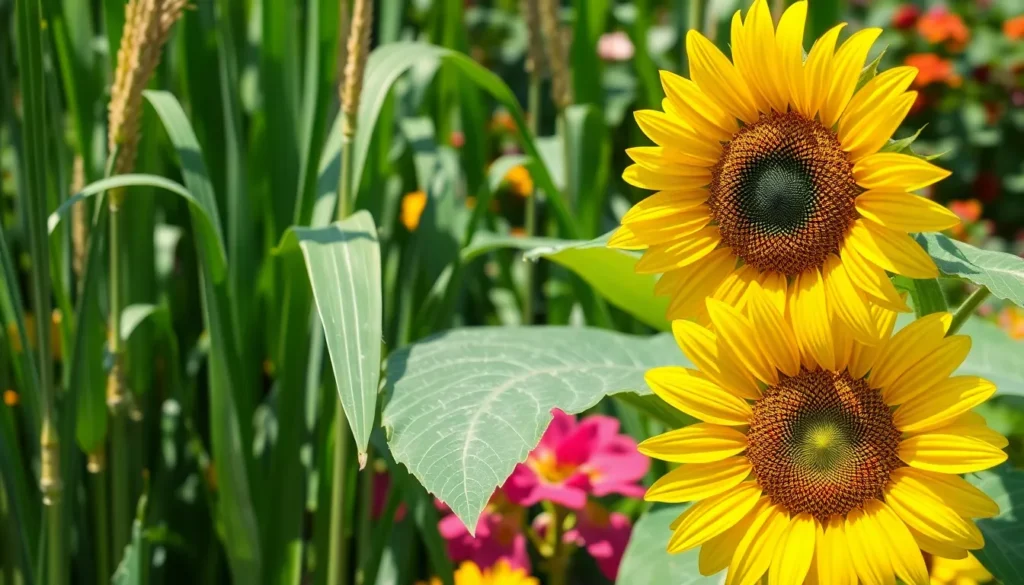When we step into any garden or walk through a forest, we’re surrounded by an incredible diversity of plant life that can be organized into two fundamental categories: monocots and dicots. These aren’t just fancy botanical terms – they’re the key to understanding how every flowering plant on Earth develops and thrives.
Whether you’re admiring the elegant simplicity of a tulip or marveling at the broad leaves of an oak tree, you’re witnessing the fascinating differences between these two plant groups. From the way their seeds first sprout to how their leaves are arranged, monocots and dicots follow distinctly different blueprints that have shaped our natural industry for millions of years.
We’ll explore the remarkable characteristics that set these plant families apart and discover why understanding this classification system can transform how you view the botanical industry around you. Get ready to see your garden – and every plant you encounter – with completely new eyes.
Understanding the Basic Differences Between Monocot and Dicot Plants
The fundamental distinctions between monocots and dicots begin at the cellular level and extend throughout their entire plant structure. These differences shape how each plant type grows, develops, and functions in nature.
Seed Structure Variations
Cotyledons determine the primary classification between monocot and dicot plants. Monocot seeds contain a single cotyledon (seed leaf), while dicot seeds feature two cotyledons that store nutrients for the developing seedling.
Endosperm storage varies significantly between these plant types. Monocot seeds like corn and wheat retain their endosperm tissue throughout germination, providing continuous nourishment to the growing plant. Dicot seeds such as beans and sunflowers absorb their endosperm into the cotyledons before germination occurs.
Seed coat thickness differs markedly in each classification. Monocot seeds typically develop thinner, more flexible seed coats that allow for easier water absorption during germination. Dicot seeds often possess thicker, harder seed coats that require exact environmental conditions to break dormancy.
Germination patterns reflect structural differences between monocot and dicot seeds. Monocot seeds like grass and rice emerge with their cotyledon remaining below ground (hypogeal germination). Dicot seeds including tomatoes and radishes push their cotyledons above the soil surface (epigeal germination).
Embryo Development Patterns
Apical meristem formation establishes the growth pattern for each plant type. Monocot embryos develop a single apical meristem at the shoot tip, creating their characteristic parallel leaf venation. Dicot embryos form multiple meristems that produce the branching vein patterns we observe in their leaves.
Root system architecture originates from embryonic structures called radicles. Monocot embryos develop fibrous root systems with many thin roots of similar size spreading horizontally. Dicot embryos create taproot systems featuring one dominant central root with smaller lateral branches.
Vascular bundle arrangement begins during embryonic development and continues throughout plant growth. Monocot embryos establish scattered vascular bundles throughout their stems, creating a distributed transport system. Dicot embryos organize their vascular bundles in a circular pattern around the stem’s perimeter.
Leaf development patterns emerge from embryonic tissue organization. Monocot embryos produce leaves with parallel venation that reflects their internal vascular structure. Dicot embryos generate leaves with net-like (reticulate) venation patterns that branch extensively from main veins.
Identifying Monocot Plants Through Their Distinctive Characteristics

Recognizing monocot plants becomes straightforward when we understand their three key identifying features. These characteristics work together to create a clear pattern that distinguishes them from their dicot counterparts.
Parallel Leaf Venation Patterns
Parallel venation serves as the most reliable visual identifier for monocot plants. Veins run side by side along the length of the leaf, creating straight lines that extend from the base to the tip without branching or connecting. This pattern contrasts sharply with the web-like network we see in dicot leaves.
Grass blades demonstrate this pattern perfectly, with their distinct parallel lines running the entire length of each blade. Corn leaves, lily foliage, and tulip leaves all showcase this same venation style. We can easily spot this characteristic by holding any suspected monocot leaf up to the light, where the parallel veins become clearly visible.
Fibrous Root System Structure
Fibrous root systems characterize all monocot plants through their network of many thin roots that spread horizontally. These roots lack a single dominant taproot, instead forming a mat-like structure that extends outward from the plant’s base. The system consists of many roots of similar thickness that branch repeatedly to create an extensive underground network.
Grass lawns exemplify this root structure, with their shallow but widespread root systems that help prevent soil erosion. Onions, wheat, and rice plants all develop these fibrous root networks that excel at absorbing water and nutrients from the upper soil layers. This root arrangement makes monocots particularly effective at stabilizing soil and accessing surface moisture.
Flower Parts in Multiples of Three
Flower parts arranged in multiples of three provide the final confirmation of monocot classification. Petals, sepals, stamens, and pistils all appear in groups of three or six, creating symmetrical floral displays that follow this mathematical pattern consistently.
Lilies showcase this pattern beautifully with their six petals (two sets of three), six stamens, and three-part pistils. Tulips display three outer petals and three inner petals, along with six stamens arranged in two rings of three. Iris flowers demonstrate this principle with their three large petals and three smaller sepals, plus three stamens positioned strategically within the bloom.
Recognizing Dicot Plants by Their Unique Features
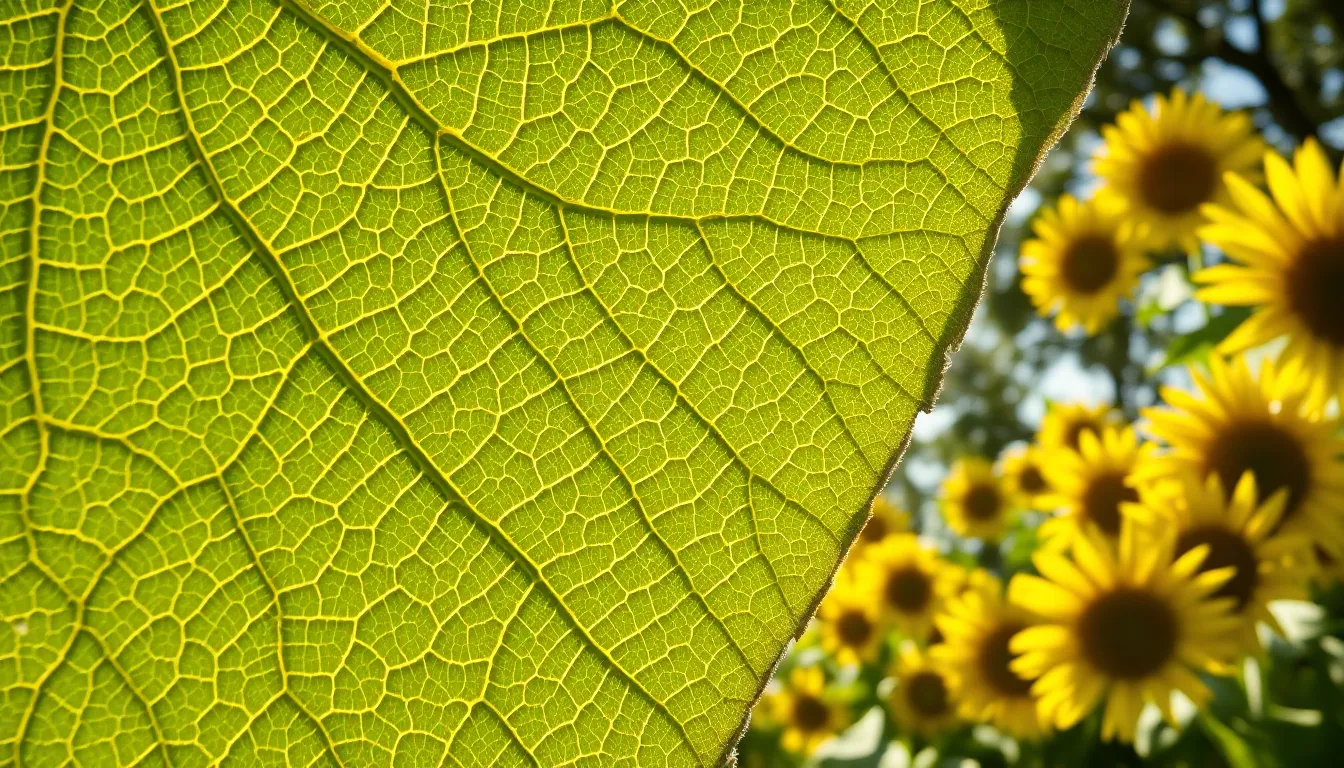
Now that we’ve explored monocot characteristics, let’s examine the distinctive features that help us identify dicot plants in our gardens and natural environments.
Netted Leaf Venation Networks
Dicots exhibit netted (reticulate) leaf venation, where veins form branching networks throughout the leaf surface. We can observe this intricate pattern by holding a dicot leaf up to the light, revealing a complex web of interconnected veins that branch and rebranch like a road system. Major veins extend from the leaf’s base and divide into smaller secondary veins, which further split into tiny tertiary veins. This network structure contrasts sharply with the parallel lines we see in monocot leaves.
Examples of plants displaying this netted venation include oak trees, roses, sunflowers, and maple trees. The branching pattern allows for efficient nutrient and water distribution throughout the entire leaf surface, supporting the diverse leaf shapes we find in dicot species.
Taproot System Formation
Dicots develop a taproot system characterized by one large, central root that grows deep into the soil. This primary root extends vertically downward and produces smaller lateral roots that branch off from the main root. We can easily identify this system by examining plants like carrots, radishes, or dandelions, where the thick central root is clearly visible.
The taproot system provides several advantages for dicot plants. It anchors the plant securely in the ground and reaches deep water sources during drought conditions. Many dicots store nutrients in their taproots, making vegetables like beets, turnips, and parsnips valuable food sources. This root structure also explains why some dicot weeds are difficult to remove from gardens unless we extract the entire taproot.
Flower Parts in Multiples of Four or Five
Flowers of dicots usually have petals and other parts in multiples of four or five, creating symmetrical patterns that are easily recognizable. We can count the petals, sepals, stamens, and pistils to confirm this characteristic. For instance, wild roses typically display five petals, while members of the mustard family often show four petals arranged in a cross pattern.
This floral arrangement differs significantly from the three part pattern we observe in monocot flowers. Common examples include apple blossoms with five petals, cherry flowers with five petals, and snapdragons with irregular but five part flower structures. Understanding this pattern helps us quickly categorize flowering plants and appreciate the mathematical precision found in nature’s designs.
Examining Stem Anatomy Differences in Monocot and Dicot Plants
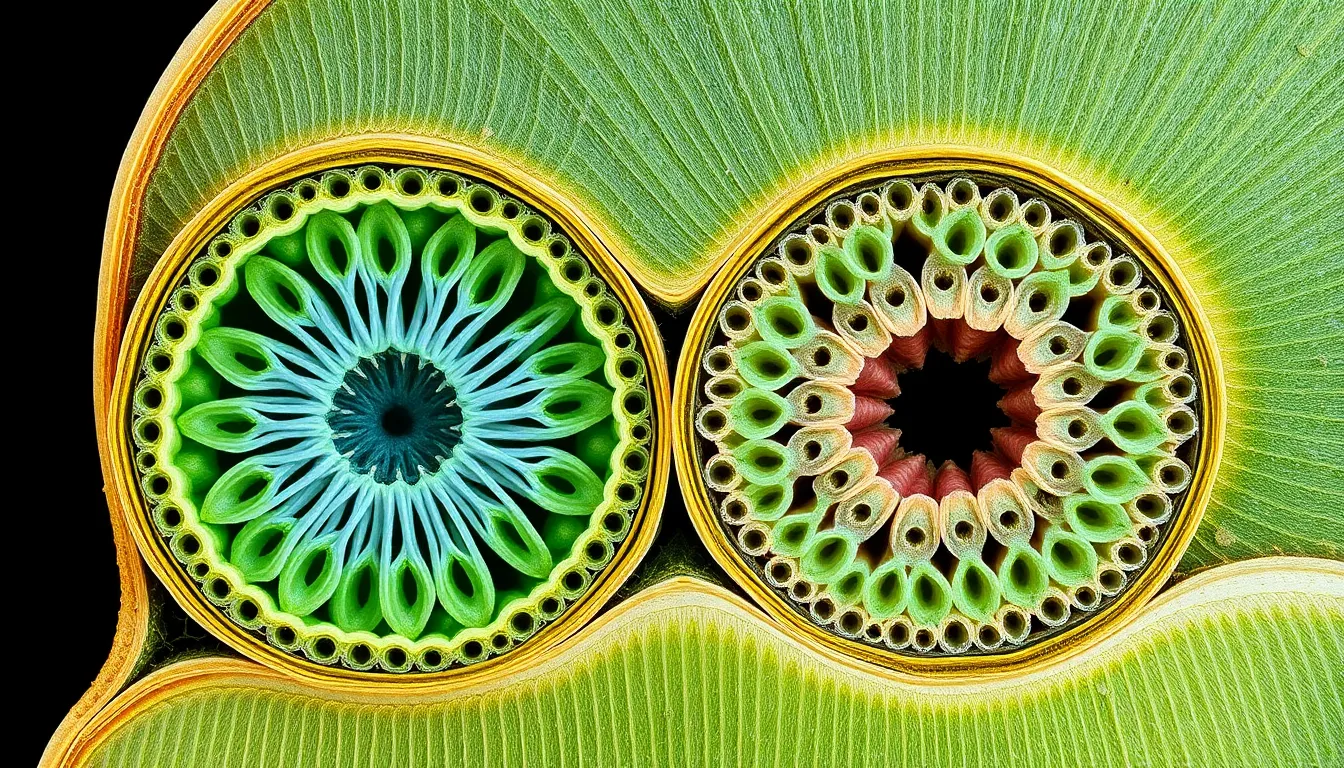
Moving beyond external features, we can discover fascinating structural differences by examining the internal anatomy of monocot and dicot stems. These anatomical variations directly influence how each plant type grows and functions throughout its lifecycle.
Vascular Bundle Arrangement Patterns
Monocot stems display scattered vascular bundles throughout their cross-section rather than following an organized pattern. We observe these bundles distributed irregularly across the entire stem, creating a flexible structure that allows plants like grasses and bamboo to bend without breaking. Each bundle appears rounded or oval-shaped and connects to others in distinctive Y-shaped patterns.
Dicot stems organize their vascular bundles in a clear ring formation around the stem’s perimeter when viewed in cross-section. This systematic arrangement creates structural support that enables secondary growth development. We find these bundles appear polygonal in shape and align themselves in organized rows or chains, providing the foundation for woody stem formation.
The scattered arrangement in monocots prioritizes flexibility and rapid movement, while the ringed pattern in dicots emphasizes structural integrity and growth potential. These contrasting arrangements reflect each plant type’s evolutionary adaptations to their exact environmental needs.
Growth Pattern Variations
Monocots remain herbaceous throughout their entire lifespan because their vascular bundles lack the necessary components for secondary growth. We see these plants maintain relatively thin stems that don’t increase in thickness over time. This growth limitation supports rapid development and maintains flexibility but restricts maximum height and girth expansion.
Dicots develop secondary growth capabilities that allow their stems to thicken and become woody as they mature. Through this process, we observe these plants forming substantial wood and bark layers that support larger, taller structures like trees and shrubs. The cambium layer continuously produces new vascular tissues, enabling dicots to achieve impressive sizes and longevity.
Growth pattern differences explain why we see towering oak trees (dicots) versus flexible grass blades (monocots) in nature. Each strategy offers distinct advantages for survival and reproduction in different ecological niches.
Cambium Layer Presence
Monocot vascular bundles are classified as closed because they completely lack a cambium layer between their xylem and phloem tissues. Without this crucial growth layer, we find that monocots cannot produce secondary vascular tissues or achieve thickness increases over time.
Dicot vascular bundles remain open due to their active cambium layer positioned between the xylem and phloem. This cambium stays functional throughout the plant’s life, continuously generating new secondary tissues that enable stem thickening. We observe this cambium activity as the primary driver of woody growth and the key factor in dicot longevity.
Beyond cambium differences, we notice that monocot stems often develop hollow centers while dicot stems typically remain solid throughout. The hypodermis layer in dicots consists of collenchyma fibers and may feature trichomes, structures that are absent in monocots.
Exploring Leaf Structure Variations Between Plant Types
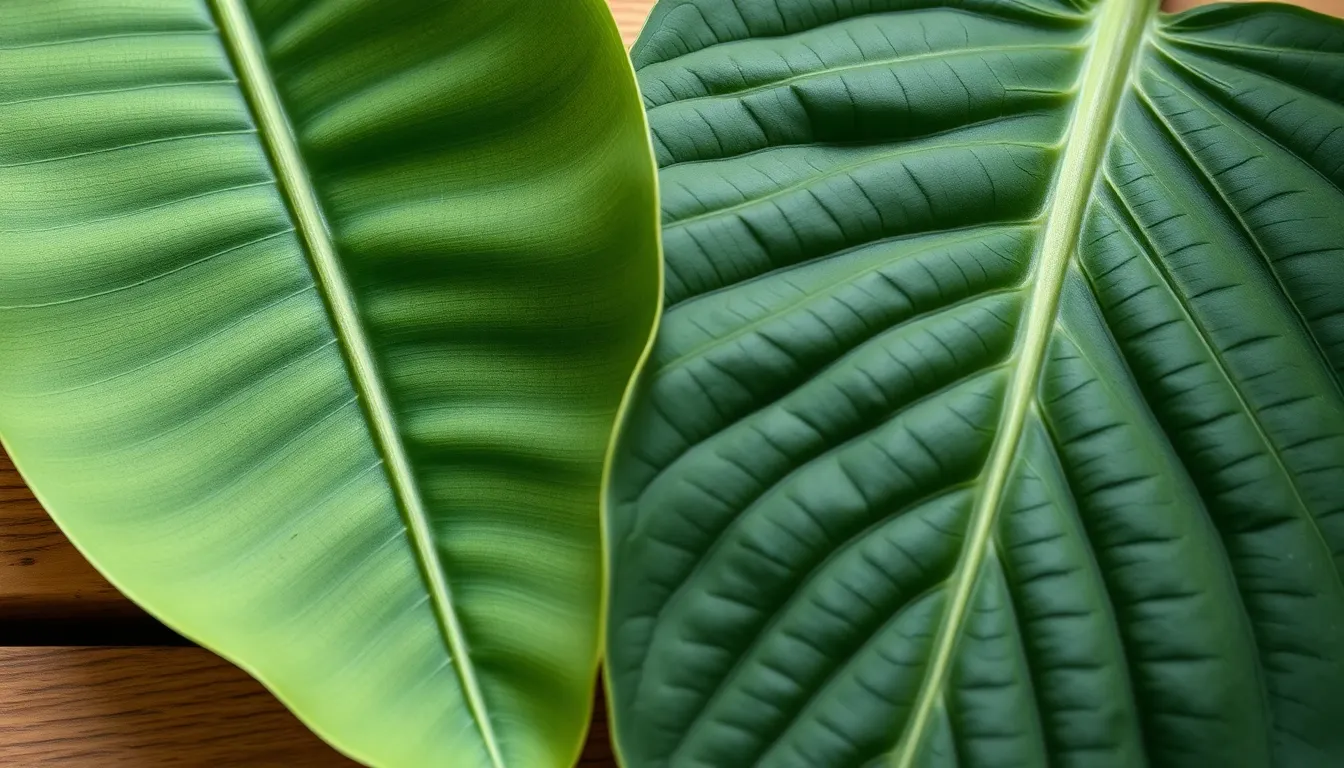
We’ve covered the fundamental structural differences in stems and roots, but leaf anatomy reveals equally fascinating distinctions between monocots and dicots. These variations directly impact how each plant type functions and survives in different environments.
Stomatal Distribution Differences
Monocots position stomata on both upper and lower leaf surfaces, creating what botanists call an amphistomatous arrangement. This equal distribution allows gas exchange from both sides of the leaf, maximizing carbon dioxide uptake for photosynthesis. Grasses and corn plants exemplify this efficient system, enabling them to thrive in open, sunny environments.
Dicots take a different approach by concentrating more stomata on the lower leaf surface than the upper surface, following a hypostomatous pattern. This strategic placement reduces water loss while still maintaining adequate gas exchange for photosynthesis. Oak leaves and rose plants demonstrate this adaptation, which helps them conserve moisture in varied environmental conditions.
Leaf Shape and Margin Characteristics
Monocot leaves typically display linear shapes with smooth, unbroken margins that minimize surface area exposure to intense sunlight. These narrow, slender leaves help reduce water loss while maintaining photosynthetic efficiency. Grass blades and lily leaves showcase this streamlined design that’s perfectly adapted to their ecological niches.
| Characteristic | Monocots | Dicots |
|---|---|---|
| Shape | Linear, narrow, slender | Broad, varied shapes |
| Margins | Smooth, unbroken | Serrated, lobed, complex |
| Surface Area | Reduced exposure | Increased photosynthetic area |
Dicots exhibit broader leaves with complex margins that are often serrated or deeply lobed. These intricate edges increase the total surface area available for photosynthesis, allowing plants to capture more light energy. Maple leaves and sunflower foliage exemplify this design, which maximizes photosynthetic efficiency in diverse environmental conditions.
Photosynthetic Adaptations
Bulliform cells in monocot leaves create specialized folding mechanisms that adjust light interception and water conservation simultaneously. These unique cells contract and expand to roll or fold leaves during water stress, protecting the plant from excessive moisture loss. Rice and wheat plants use this adaptation to survive in challenging growing conditions.
Amphistomatous leaf structure in monocots enables efficient carbon dioxide uptake from both leaf surfaces, supporting robust photosynthetic activity. This dual access system allows plants to maintain high productivity even when environmental conditions vary. Corn and barley plants benefit significantly from this enhanced gas exchange capability.
Reticulate venation in dicot leaves supports extensive transport networks that efficiently move water and nutrients throughout the leaf tissue. These branching vein patterns create multiple pathways for resource distribution, ensuring all leaf areas receive adequate supplies for photosynthesis. Apple trees and bean plants demonstrate how this network system supports their complex leaf structures and varied growing environments.
Comparing Root System Development and Function
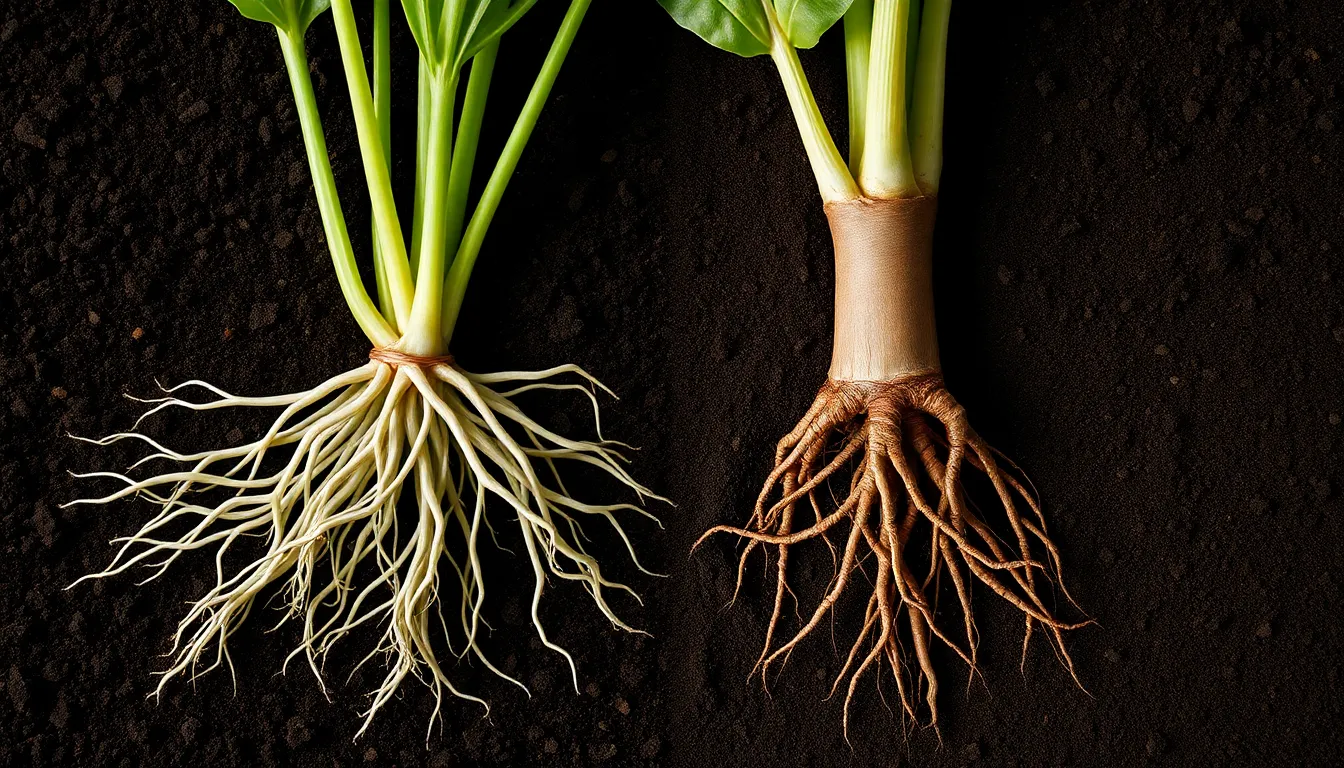
We’ve seen how monocots and dicots differ in their surface features, but their root systems reveal even more dramatic contrasts. These underground networks showcase distinct evolutionary approaches to survival and resource management.
Water and Nutrient Absorption Methods
Monocots employ their fibrous root systems to create extensive horizontal networks that maximize surface area contact with upper soil layers. These slender roots spread outward from the stem base, forming dense mats that efficiently capture water and nutrients from shallow soil zones where organic matter concentrates.
Dicots use their taproot systems to penetrate deep into the earth, accessing water reserves and mineral deposits that surface roots can’t reach. This vertical approach proves especially valuable during drought conditions when surface moisture disappears but deeper soil layers retain water.
Both systems optimize resource uptake within their respective soil territories, with monocots excelling at rapid absorption from rainfall and surface nutrients while dicots tap into stable underground water sources and deep mineral deposits.
Soil Anchoring Mechanisms
Fibrous root systems in monocots create exceptional soil binding capacity through their dense network of thin roots that weave throughout the upper soil profile. This horizontal root mat prevents erosion effectively but provides limited resistance to strong vertical forces like high winds.
Taproot systems in dicots deliver superior vertical anchoring strength by driving deep into the ground like natural stakes. The main root’s substantial diameter and depth create rock solid stability that keeps tall plants upright during storms and extreme weather events.
Monocots compensate for their shallow anchoring through sheer numbers, while dicots rely on their single powerful taproot to provide unwavering structural support for larger plant bodies.
Storage Capacity Differences
Dicot taproots frequently function as specialized storage organs that accumulate carbohydrates, nutrients, and water for future use. Plants like carrots and radishes demonstrate this capacity by developing thick, fleshy roots that sustain growth during dormant periods or support rapid spring regrowth.
Monocot fibrous roots focus primarily on absorption and support rather than storage since their thin structure limits space for nutrient reserves. These roots channel resources directly to above ground plant parts instead of banking them underground.
This storage difference impacts plant life cycles significantly, with dicot perennials using stored root energy to survive harsh seasons while monocots typically rely on above ground storage organs or complete their life cycles within single growing seasons.
Analyzing Reproductive Structures and Pollination Strategies

When we examine how monocots and dicots reproduce, we discover fascinating differences in their flower structures and pollination methods that reflect millions of years of evolutionary adaptation.
Flower Symmetry Patterns
Dicot flowers showcase remarkable diversity in their symmetry patterns, displaying two distinct forms that enhance their pollination success. Radial symmetry creates flowers that look identical from any angle around their central axis, like the perfect circular arrangement we see in wild roses and sunflowers. Bilateral symmetry produces flowers that mirror each other along only one plane, creating the distinctive shapes we observe in orchids and snapdragons.
Monocot flowers generally maintain radial symmetry throughout their structure, creating the balanced three part arrangements we recognize in lilies and tulips. This consistent symmetry pattern helps attract pollinators from multiple directions and supports the efficient distribution of reproductive organs. Species variations do occur within monocot families, but the radial pattern remains the dominant characteristic across most monocot flowering plants.
Pollen Grain Characteristics
Dicot pollen grains feature a triporate structure with three distinct furrows or pores that serve as exit points for pollen tubes during fertilization. These specialized openings provide multiple pathways for successful reproduction and increase the chances of successful pollination events. The three pore design offers backup options when one or two pores become blocked or damaged during the pollination process.
Monocot pollen grains typically develop with a single pore or furrow, creating a more streamlined approach to pollen tube emergence. This simplified structure reflects the different pollination strategies employed by monocot plants and their evolutionary adaptations. Variations exist among different monocot species, but the single opening design remains characteristic of this plant group’s reproductive strategy.
Seed Dispersal Methods
Both monocot and dicot plants have evolved diverse seed dispersal strategies based on their exact habitats and environmental challenges. Wind dispersal proves particularly effective for monocot grasses, which release lightweight seeds that travel considerable distances on air currents. Wheat, rice, and corn use this method to colonize new areas and ensure species survival across broad geographic regions.
Animal dispersal occurs more frequently among dicot plants, especially those producing fleshy fruits that attract birds and mammals. Apples, berries, and nuts rely on animals to transport their seeds to suitable growing locations through consumption and subsequent excretion. This partnership benefits both the plants and the animals, creating successful ecological relationships.
Mechanical dispersal involves explosive seed release mechanisms that both plant groups employ when environmental conditions trigger rapid seed ejection. Touch me nots and some bean species demonstrate this dramatic dispersal method by forcefully launching seeds away from the parent plant. Water dispersal also serves both monocots and dicots living near streams, rivers, and wetland environments where flowing water carries seeds to new locations.
Understanding Economic Importance of Monocot and Dicot Plants
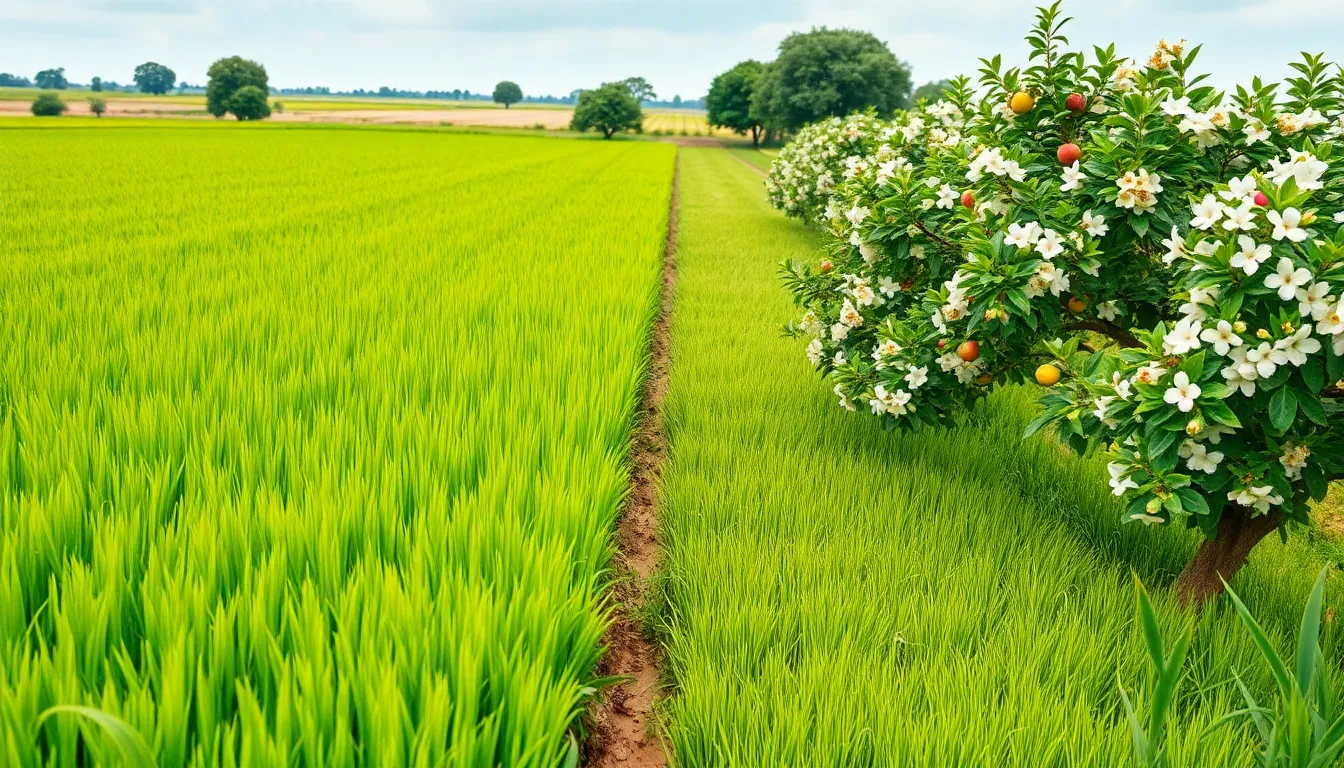
Beyond their fascinating structural differences, monocot and dicot plants form the foundation of our global economy and daily lives. We’ll explore how these two plant groups contribute to agriculture, commerce, and medicine worldwide.
Agricultural Crop Classifications
Monocots dominate global food production through staple crops that feed billions of people daily. Rice, wheat, and maize (corn) represent the most economically important monocot crops, all belonging to the grass family (Poaceae). These crops form the backbone of global food security and agriculture worldwide.
Sugarcane stands out as another vital monocot crop for both food and biofuel production. We rely on sugarcane for approximately 80% of the industry’s sugar supply, making it one of the most economically important monocot species.
Dicots cover a broader variety of agricultural products including fruit bearing trees like apples and oranges. Legumes such as beans and peas contribute extensively to biodiversity and human nutrition by fixing nitrogen in soil. Vegetable crops from dicot families provide essential vitamins and minerals in our diets.
Commercial Plant Products
Monocots serve as primary sources for biofuels and animal feed beyond their role as food crops. Corn ethanol production represents a multi billion dollar industry that reduces our dependence on fossil fuels. Grasses and cereal crops provide essential fodder for livestock operations worldwide.
Dicots supply many commercial products that support various industries. Timber from dicot trees like oak and maple creates furniture, construction materials, and paper products. Cotton fibers from dicot plants form the foundation of the textile industry.
Ornamental plants from both groups contribute significantly to landscaping and horticulture industries. We use dicot flowering plants extensively in gardens and commercial landscaping projects. Palm trees and other monocot ornamentals enhance tropical and subtropical environments.
Pharmaceutical Applications
Both monocots and dicots serve as sources for medicinal compounds that support pharmaceutical industries. Many dicot plants in the family Fabaceae provide alkaloids, flavonoids, and other compounds used in drug development. These natural compounds form the basis for many prescription medications.
Monocot species contribute to traditional medicines and phytochemical extraction processes. Certain grass species and palm derivatives support pharmaceutical applications through their unique chemical compositions. We extract valuable compounds from various monocot plants for both traditional and modern medical treatments.
Drug development relies heavily on both plant groups for discovering new therapeutic compounds. Research continues to identify promising medicinal properties in previously unstudied species from both monocot and dicot families.
Evolutionary Relationships and Plant Classification
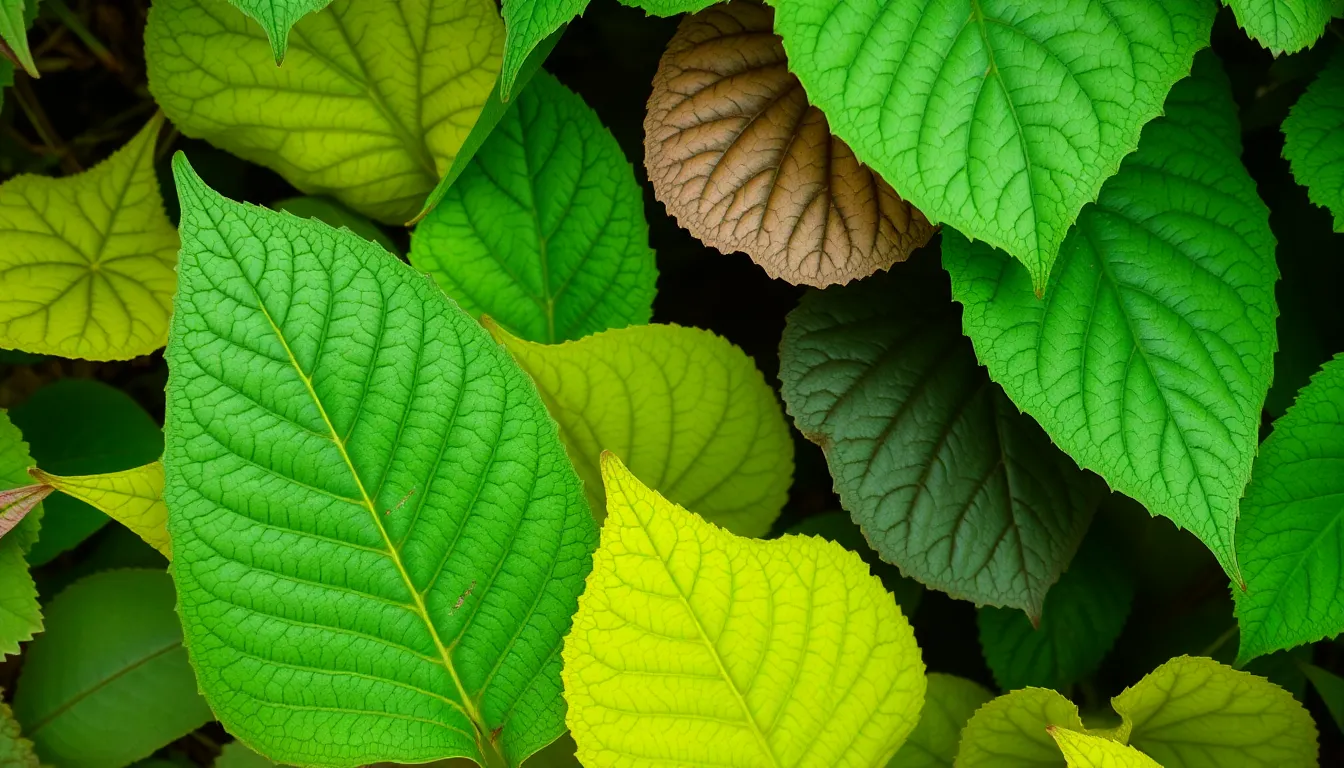
Understanding the evolutionary journey of monocots and dicots requires us to look beyond traditional plant classifications. Modern molecular research has revolutionized our comprehension of how these flowering plant groups developed over millions of years.
Phylogenetic Development Patterns
Phylogenetic analyses using DNA sequence data reveal that monocots evolved from within early angiosperm lineages alongside magnoliids rather than forming a separate evolutionary branch. We’ve discovered through molecular markers that the monocot lineage forms a distinct clade characterized by their single cotyledon, parallel leaf venation, and scattered vascular bundles. Scientists have determined that many groups formerly classified as dicots actually diverged at different evolutionary times, creating a more complex family tree than previously understood.
Key Phylogenetic Findings:
| Characteristic | Monocots | Traditional Dicots | Eudicots |
|---|---|---|---|
| Evolutionary timing | Early angiosperm lineage | Multiple divergence points | Separate major lineage |
| Cotyledon number | Single | Two | Two |
| Pollen structure | Single pore | Variable | Three apertures |
| Genetic markers | Distinct clade traits | Mixed characteristics | Exact molecular signatures |
Molecular studies demonstrate that dicots don’t form a monophyletic group because they don’t contain all descendants of a common ancestor. The true monophyletic group within dicots is termed “eudicots,” distinguished by pollen grains with three apertures that represent a large evolutionary clade separate from monocots.
Fossil Record Evidence
Fossil discoveries support the early divergence of monocots and magnoliid related dicots through anatomical and morphological evidence. We’ve found fossils of basal angiosperms like Magnolia and water lilies (Nymphaea) that predate the monocot lineage, providing crucial insights into early flowering plant evolution. These preserved specimens show anatomical structures consistent with molecular data, indicating a complex pattern of early angiosperm development rather than a simple two group split.
Archaeological evidence reveals that early flowering plants exhibited diverse characteristics that don’t fit neatly into traditional monocot or dicot categories. Fossilized plant remains demonstrate transitional forms that bridge the gap between different angiosperm lineages, supporting the molecular findings about their evolutionary relationships.
Modern Taxonomic Approaches
Modern taxonomy has moved beyond the strict monocot dicot division to embrace a more accurate classification system based on molecular phylogenetics. We now recognize monocots as a coherent clade while classifying most former dicots into various groups, particularly the eudicots, using the APG IV system established in 2016. This contemporary approach integrates classical morphological traits with evolutionary data through genetic sequencing to produce classifications that reflect evolutionary history more faithfully.
Scientists use molecular data and fossil evidence to create taxonomic frameworks that better represent plant relationships. Current classification systems acknowledge monocots, magnoliids, and eudicots as distinct evolutionary clades, transforming our understanding of angiosperm diversity and relationships through advanced phylogenetic analysis techniques.
Practical Applications for Identifying Monocot and Dicot Plants

Understanding the structural differences between monocots and dicots extends far beyond academic knowledge. These distinctions directly impact our daily decisions in gardening, farming, and education.
Garden and Landscaping Decisions
Plant placement strategies become more effective when we recognize whether we’re working with monocots or dicots. Monocots with their fibrous root systems spread horizontally, making them ideal for preventing soil erosion on slopes and creating dense ground cover. Grasses, irises, and daylilies establish quickly in shallow soil layers and require less deep soil preparation.
Watering schedules differ significantly between plant types based on their root architecture. Dicots with taproot systems need deep, infrequent watering to encourage downward root growth, while monocots benefit from frequent, shallow watering that reaches their horizontal root networks. Oak trees and carrots require different irrigation approaches than corn and onions.
Companion planting decisions work best when we match plants with similar root systems and growth patterns. Combining monocots like ornamental grasses with dicots such as flowering perennials creates balanced garden designs that use different soil layers effectively. This pairing reduces competition for nutrients and water resources.
Maintenance requirements vary based on structural characteristics we can identify through parallel versus netted leaf venation. Monocots typically require less pruning since they lack secondary growth, while dicots with their cambium layers need regular trimming to maintain shape and health.
Agricultural Planning Strategies
Crop rotation planning relies heavily on distinguishing between monocot and dicot families to prevent soil depletion. Alternating between monocot crops like wheat and rice with dicot legumes such as soybeans and beans helps maintain soil nitrogen levels naturally. This practice reduces fertilizer costs and improves long term soil health.
Fertilizer application methods require different approaches based on root system architecture. Monocots with scattered vascular bundles and fibrous roots benefit from broadcast fertilization across the soil surface, while dicots with organized vascular systems and taproots need targeted deep fertilization around the root zone.
Pest management strategies become more targeted when we understand plant anatomy differences. Monocots with their parallel leaf venation often host different pest species than dicots with netted venation patterns. Identifying plant type helps farmers select appropriate pesticides and biological control methods.
Harvest timing decisions depend on recognizing flower part arrangements in multiples of three for monocots versus multiples of four or five for dicots. This knowledge helps determine optimal pollination periods and fruit development stages for maximum yield.
Educational Field Study Methods
Student observation exercises become more structured when we teach the one cotyledon versus two cotyledons distinction in germinating seeds. Bringing wheat seeds and bean seeds to class demonstrations allows students to see embryonic leaf differences firsthand and understand early plant development stages.
Field identification activities work best when students learn to spot parallel venation in grass blades versus the branching networks in oak leaves. Creating identification charts with local examples helps students recognize these patterns in their own neighborhoods and school grounds.
Laboratory experiments comparing stem cross sections reveal the scattered vascular bundles of monocots versus the organized ring patterns of dicots. Using corn stalks and sunflower stems provides clear visual evidence of internal structural differences that students can examine under microscopes.
Data collection projects engage students in measuring and recording differences in root system spread between fibrous and taproot types. Comparing the horizontal root networks of grass lawns with the deep taproots of dandelions creates meaningful learning experiences about plant survival strategies.
Conclusion
Understanding the differences between monocots and dicots opens up a intriguing area of botanical knowledge that we can apply in countless ways. From the parallel veins in grass blades to the intricate networks in oak leaves these structural differences tell the story of millions of years of plant evolution and adaptation.
We’ve explored how these fundamental distinctions affect everything from root development to flower structure and how this knowledge translates into practical benefits for gardening agriculture and education. Whether we’re planning our next garden layout or simply taking a walk through nature we now have the tools to appreciate the incredible diversity of flowering plants around us.
The next time we encounter a plant we’ll be able to identify its classification and understand the remarkable adaptations that have allowed both monocots and dicots to thrive in their respective environments. This deeper understanding enriches our connection to the natural industry and enhances our ability to work with plants more effectively.
Frequently Asked Questions
What are the two main categories of flowering plants?
The two main categories of flowering plants are monocots and dicots. These classifications are based on fundamental structural differences in their seeds, roots, stems, leaves, and flowers. Understanding these categories helps botanists and gardeners better appreciate plant diversity and make informed decisions about cultivation and care.
What is the main difference between monocot and dicot seeds?
Monocot seeds have a single cotyledon (seed leaf), while dicot seeds have two cotyledons. Additionally, monocots retain their endosperm during germination for nutrition, whereas dicots absorb the endosperm into their cotyledons before germination, making the cotyledons the primary food source for the developing plant.
How can I identify a monocot plant by its leaves?
Monocot leaves display parallel venation, where veins run side by side without branching, similar to grass blades or corn leaves. They typically have linear, narrow shapes and stomata on both upper and lower surfaces. Many monocots also possess specialized bulliform cells for water conservation.
What type of root system do monocots have?
Monocots have fibrous root systems consisting of a network of thin roots that spread horizontally near the soil surface. This system is efficient for absorbing water and nutrients from shallow soil layers, as seen in grass lawns, onions, and rice plants.
How are monocot flowers structured?
Monocot flowers have parts arranged in multiples of three, such as three or six petals. They typically maintain radial symmetry and can be easily identified by counting their petals, sepals, or stamens. Examples include lilies, tulips, and irises.
What distinguishes dicot leaves from monocot leaves?
Dicot leaves exhibit netted (reticulate) venation, where veins form intricate branching networks throughout the leaf. They often have broader, more complex shapes with serrated margins and concentrate their stomata primarily on the lower leaf surface to reduce water loss.
What type of root system do dicots have?
Dicots develop taproot systems characterized by a single, deep central root that provides stability and accesses deep water sources. This system is excellent for drought resistance and often serves as storage for carbohydrates and nutrients, as seen in carrots and dandelions.
How can I identify dicot flowers?
Dicot flowers typically have parts arranged in multiples of four or five, such as five petals in wild roses. They can display both radial symmetry (like sunflowers) and bilateral symmetry (like snapdragons), offering more diverse flower structures than monocots.
What are the stem differences between monocots and dicots?
Monocot stems have scattered vascular bundles and remain herbaceous without secondary growth, often featuring hollow centers. Dicot stems have vascular bundles arranged in rings with an active cambium layer, allowing them to develop woody tissue and achieve greater size and longevity.
Which plant group is more important for global food production?
Monocots dominate global food production with staple crops like rice, wheat, and maize providing the majority of human calories. However, dicots contribute significantly through fruit trees, vegetables, legumes, and other diverse agricultural products essential for balanced nutrition.
Can understanding monocots and dicots help with gardening?
Yes, understanding these plant types helps with garden planning, including proper plant placement, watering schedules based on root systems, and companion planting strategies. It also informs maintenance requirements and helps predict how plants will grow and respond to different conditions.
What are some practical ways to teach students about monocots and dicots?
Effective teaching methods include hands-on observation exercises, field identification activities, and laboratory experiments examining plant structures. Students can practice identifying plants in school gardens, create comparison charts, and conduct germination experiments to see the differences firsthand.

